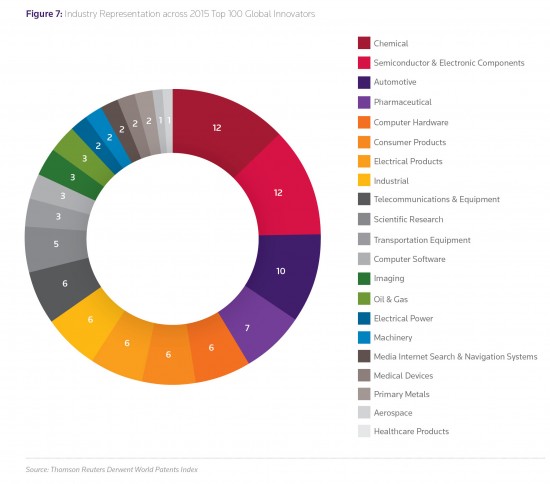 It’s been awhile since e-commerce was lauded as the cradle of new innovation. Sure, in 1999, when shopping on the Internet was still a relatively new concept and a start-up digital bookseller named Amazon.com filed a patent for “1-Click” ordering, e-commerce was synonymous with marketplace disruption. But now, 16 years later, with e-commerce having become such a massive retail establishment, is it possible for companies like Amazon to continue to break new ground?
It’s been awhile since e-commerce was lauded as the cradle of new innovation. Sure, in 1999, when shopping on the Internet was still a relatively new concept and a start-up digital bookseller named Amazon.com filed a patent for “1-Click” ordering, e-commerce was synonymous with marketplace disruption. But now, 16 years later, with e-commerce having become such a massive retail establishment, is it possible for companies like Amazon to continue to break new ground?
According to Thomson Reuters 2015 list of Top 100 Global Innovators, Amazon and several other established players in mature markets are proving that it’s not just start-ups that have the potential to upend traditional business models and reinvent our world. In fact, several of the companies new to this year’s ranking of top innovators have been around a lot longer than Amazon, among them: Boehringer Ingelheim, Chevron, Exxon Mobil, Johnson Controls, Thales, and Yamaha.
What are these companies doing to join the ranks of fast-moving, tech-oriented companies like Apple, Google and Intel, which are more traditionally associated with pushing the boundaries of innovation?
For one, they are investing heavily in R&D. Collectively, the 100 companies on this year’s list spent 1.86 percentage points more on market-cap-weighted R&D than the constituents of the MSCI World Index. This is an important statistic, because it shows that real innovation adheres to the lifecycle of innovation. That is the harnessing of concerted R&D through research and discovery, the protection of inventions with intellectual property rights, and the successful commercialization of the idea.
The innovation lifecycle is clearly on display among the companies joining the top innovators list for the first time this year. In the case of Amazon, it has been generating dozens of new inventions every month in a broad range of technology areas, including data centers, devices and electronic methods and systems. Philosophically, it looks as if Amazon’s founding spirit of creating the biggest retailer in the world has extended to its commitment to innovating across a constantly-expanding collection of technologies.
This approach is not exclusive to the tech space. Established industries like Oil & Gas also had its spirit of innovation awakened this year. While the Top 100 Global Innovators contained no such companies in 2014, there were three in 2015. Chevron, ExxonMobil and the Japanese petroleum giant Idemitsu Kosan all found spots among the top innovators given advancements in technologies to access natural gas and expansion into alternative energy. (See the industry breakout of all 100 innovators in Figure 1.)

Figure 1: Industry Breakout of the 2015 Thomson Reuters Top 100 Global Innovators. Source: Thomson Reuters Derwent World Patents Index.
Global pharmaceutical companies have also increased their presence on the Top 100 list by continually broadening their reach. A total of seven pharma companies were on the list this year, up from four in 2014. Both Bayer and Bristol-Myers Squibb rejoined the ranks of top innovators after being absent since 2011. Boehringer Ingelheim made it for the first time.
The trend in pharma representation on the Top 100 list is noteworthy because, although no one would dispute that pharmaceutical companies are innovative, their historically long product-development cycles have put them at a disadvantage when compared with high-tech firms that have much shorter product lifecycles. These pharmaceutical companies are proving that the mantra to fail fast, fail cheap and fail often is helping to reshape new drug development.
On the whole, the 100 companies comprising this year’s crop of Top Global Innovators earned their recognition through a combination of R&D investment, ongoing reinvention and a focus on the details. We’re able to capture a unique view into innovation by measuring overall patent volume, patent-grant success rates, global reach and invention influence as evidenced by citations. By tracking the ethereal concept of innovation with these concrete benchmarks, we are able to identify that sweet spot where pure R&D meets institutional strategy for protecting and commercializing intellectual property. Increasingly, those who get that balance right are setting the pace for their competition to follow.

![[IPWatchdog Logo]](https://ipwatchdog.com/wp-content/themes/IPWatchdog%20-%202023/assets/images/temp/logo-small@2x.png)

![[Advertisement]](https://ipwatchdog.com/wp-content/uploads/2024/04/Patent-Litigation-Masters-2024-sidebar-early-bird-ends-Apr-21-last-chance-700x500-1.jpg)

![[Advertisement]](https://ipwatchdog.com/wp-content/uploads/2021/12/WEBINAR-336-x-280-px.png)
![[Advertisement]](https://ipwatchdog.com/wp-content/uploads/2021/12/2021-Patent-Practice-on-Demand-recorded-Feb-2021-336-x-280.jpg)
![[Advertisement]](https://ipwatchdog.com/wp-content/uploads/2021/12/Ad-4-The-Invent-Patent-System™.png)







Join the Discussion
One comment so far.
Charles Pidgeon, PhD
January 5, 2016 07:41 amInstead of giving only an overview, I would have enjoyed seeing a few actual real-life examples that were done in real-time.